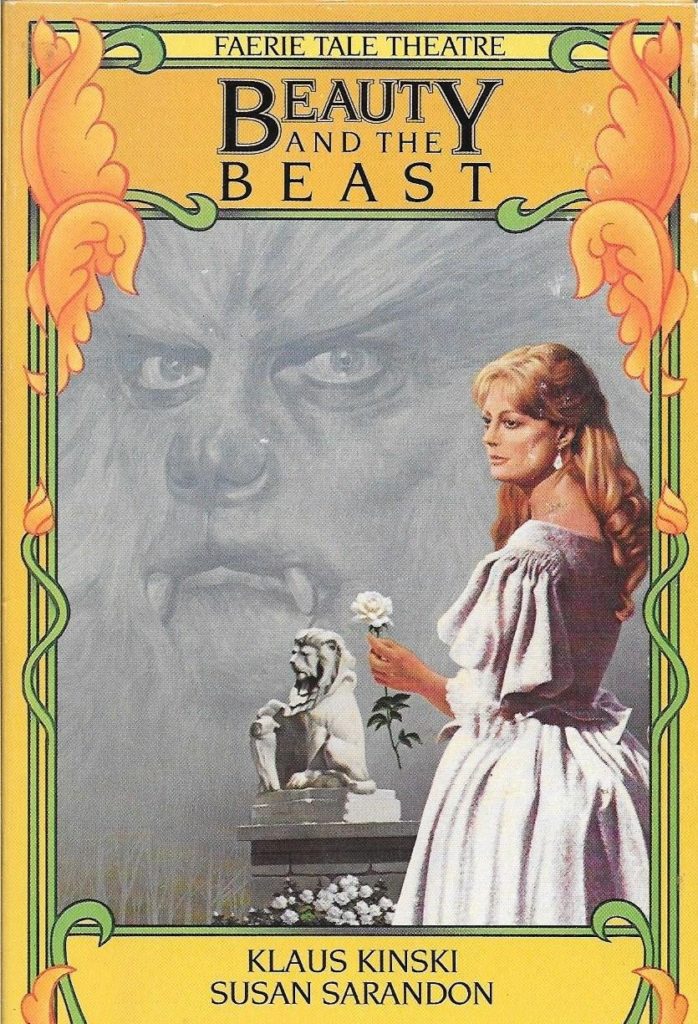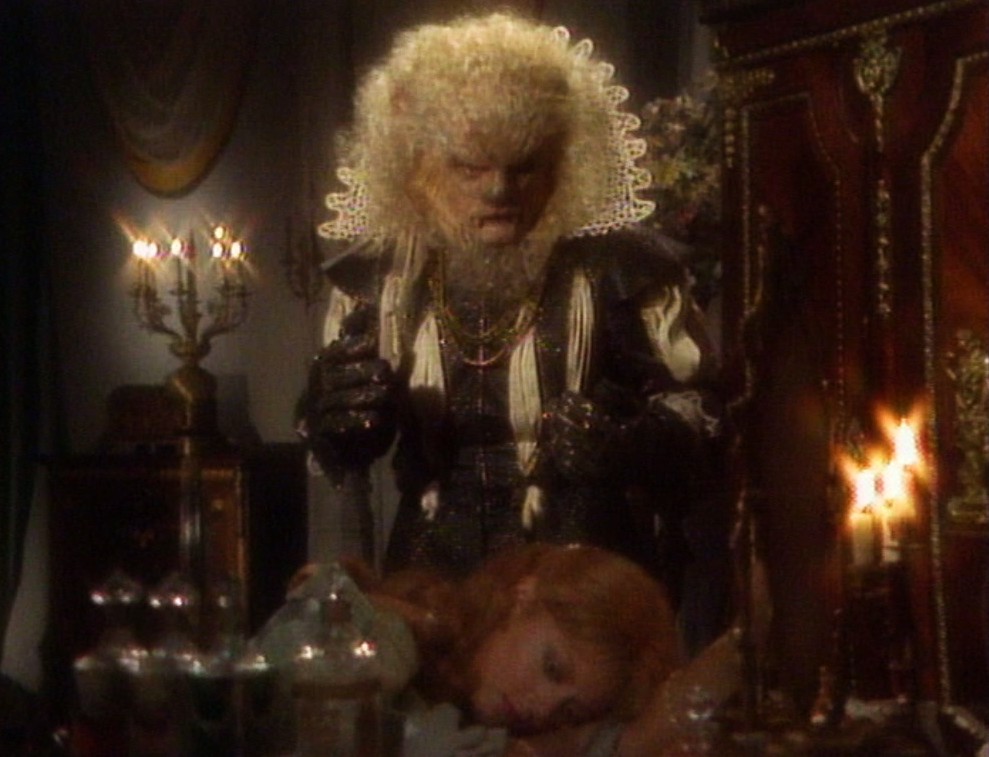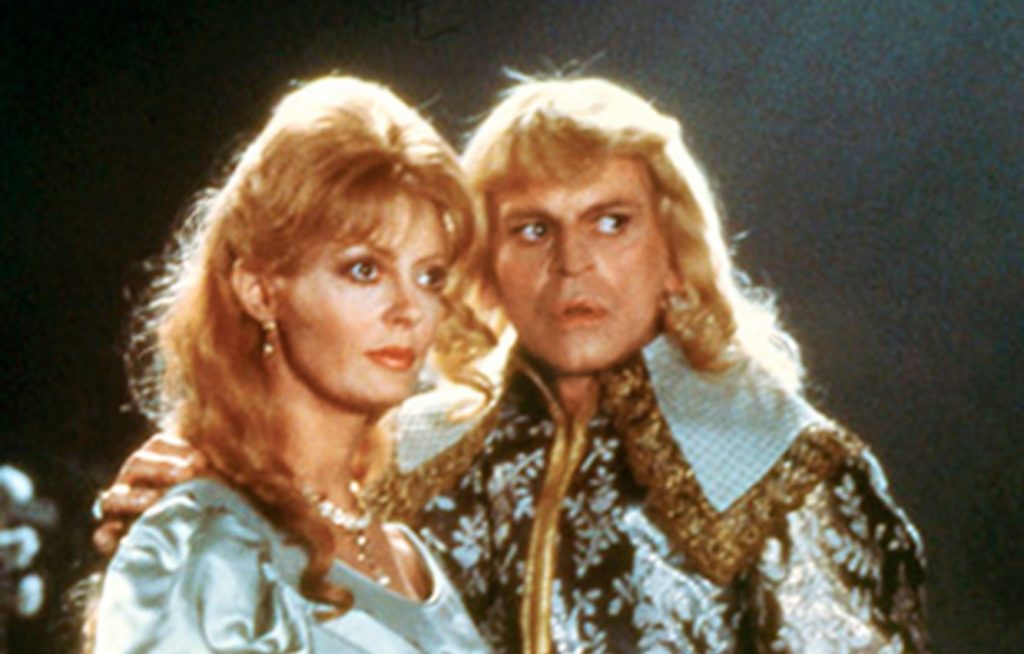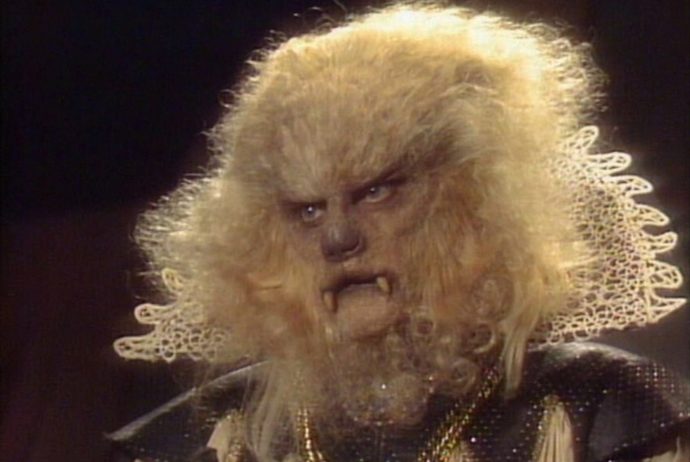Dir: Roger Vadim
Star: Susan Sarandon, Klaus Kinski, Stephen Elliott, Anjelica Huston
Shelley Duval’s Faerie Tale Theater was a series of 26 episodes over six seasons (plus one reunion special) which were made for the Showtime cable channel between 1982 and 1987. Duval came up with the idea, and acted as host for the show, introducing each story, and the talent involved was startling, on both sides of the camera. Other directors include Eric Idle, Tim Burton and Francis Ford Coppola, while virtually every episode had known faces, such as Robin Williams, Mick Jagger, Malcolm McDowell, Liza Minnelli, Paul Reubens, Carrie Fisher, Christopher Lee, Jeff Goldblium, Leonard Nimoy and Peter Weller. Beauty and the Beast was the sixth episode of the third season, airing on August 13th, 1984.
The story dates back to a French fairy-tale by Gabrielle-Suzanne Barbot de Villeneuve, first published in 1740. It has been adapted into at least a dozen movies, and this is at least one of as many again television versions. The story should likely be familiar. A merchant (Elliott) stumbles into a mysterious castle and, on taking a rose for his daughter, Beauty (Sarandon), is confronted by its beastly owner (Kinski). The Beast imposes a death sentence on the merchant, but gives him seven days to settle his affairs. On hearing this, Beauty takes her father’s place, returning to the castle to become the Beast’s companion. Every night, he asks her to marry him; every night, she declines. She is eventually given permission to visit her father, only for her absence to cause the Beast to fall into decline. Beauty returns, too late, but her final admission of love breaks the spell and he turns into a handsome prince*, and they live happily ever after**.
* for some loose definition of “handsome”. This is Klaus, who was approaching sixty and a full two decades older than Sarandon at the time. You may prefer the Beast version. I won’t judge you
** for some very loose definition of “happily ever after”. No, really: take a look at this expression on Belle’s face in the final shot, which screams Stockholm Syndrome***. It gives a whole new meaning to her final line, “I love to be afraid… with you.”
*** Probably unsurprising. According to producer Bridget Terry, “We had a hard time with Klaus Kinski… At one point, he was walking down the hallway carrying [Sarandon] for a scene, and Roger Vadim, our director, yelled “cut,” and he just dropped her. It was really tense between them.”

If you have seen Jean Cocteau’s renowned 1946 adaptation of the story, La Belle et la Bête, then large chunks of this will seem quite familiar. For example, the animated arms coming out of the wall in the Beast’s castle are clearly taken from the Cocteau version, and the same goes for other visual elements, including the costumes and make-up. It’s one of the reasons why Kinski agreed to take on the role, having worked on multiple theatrical performances of Cocteau’s works including The Typewriter and The Human Voice. According to Kinski’s autobiography, the writer sent a telegram to the producer, expressing happiness at Kinski taking on his work. Later, Kinski wrote to Cocteau for money, and was told, “I would share everything with you. Unfortunately, I own nothing. I live off the generosity of others.”
This might have been Kinski’s way of honoring his friend, Cocteau having died in 1963. It’s certainly a different choice: as noted, Klaus was almost a senior citizen and hardly a conventional handsome prince. Then again, I’ve never found Sarandon “beautiful” in the traditional sense either, so that helps balance the casting: both rely on their undoubted charisma, though Kinski as a romantic lead is always going to be a bit of a tough sell. Even as a fan, I’ve seen so many of his other roles that it’s difficult to buy into Beauty falling for him. Not that it’s a bad performance at all: what’s especially good is how much emotion Klaus is able to get through, despite being buried under extremely heavy make-up. His eyes do a lot of the talking, yet I was also impressed how little the prosthetics and fangs interfered with the delivery of his lines.

I have seen a number of Faerie Tale Theater episodes, and this one definitely does not quite fit in with the others, being notably darker in tone. The whole idea definitely plays out as if it were intended for mature viewers, which may be a result of using Vadim as a director – not exactly a man noted for children’s television! The Beast’s pain is palpable, for example, the first time that Beauty declines his marriage proposal, and there is not a great deal of light to be found until the very end. There are no dancing candlesticks or comic-relief cutlery to be found here, and the cultural dissonance resulting from the contrast to the Disney version is real: Indeed, I just realized I had called the heroine “Belle” throughout, and had to revise this. Though in fairness, calling one of your three daughters “Beauty”, while the other two are Marguerite (Huston) and Georgette (Nancy Lenehan), would appear to be asking for severe familial strife!
These elements are rather underplayed, and I feel the whole thing would have benefited had most of the scenes in Beauty’s homes, been used instead to develop her relationship with the Beast to a greater degree. At only 50 minutes long, time is of the essence, and it’s that romance which is at the story’s core, rather than the fraught relationship with her sisters, or their bickering over the best way to cook potatoes. It has been a good number of years since I saw the Cocteau version, and I’m not sure how much of this was present there. It’s either an unwarranted addition, or something that should likely have been cut in the interests of the episode as a whole. In the end, this could fairly be described as a condensed, colorized remake in English of La Belle et la Bête, which is a bit of a double-edged sword. I’ve no doubt most of the family audience on Showtime will be unaware of that version, and on its own merits, this stands up reasonably well. The more you like the original, however, the more this will likely seem superfluous at best, and bordering on blasphemy at worst.
I think of Cocteau’s magical film. I can’t think of anything else, not even when I read the hair-raising script, which degrades the most beautiful of all fairy tales to banal Hollywood trash. They promised to get Jessica Lange to costar. Instead they want to force some New York actress on me. They do give me the right to translate Cocteau’s words verbatim, from French into English – but all the other characters speak the unimaginative, proletarian, idiotic dialogue of the American TV version. The shooting is indescribable.
Kinski Uncut, p.309-310.

